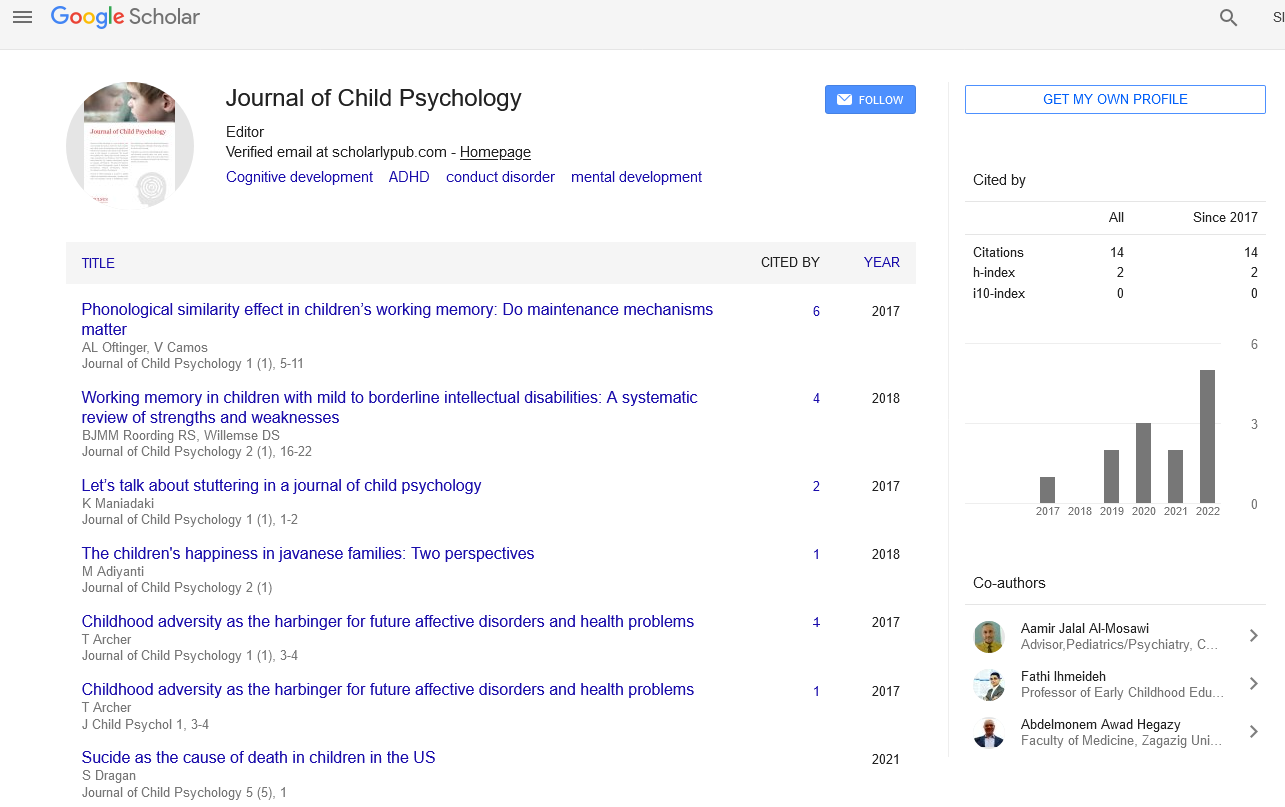Maximizing children's quality of life who have epilepsy
Received: 28-Dec-2022, Manuscript No. PULJCP-22-6003; Editor assigned: 31-Dec-2022, Pre QC No. PULJCP-22-6003 (PQ); Accepted Date: Jan 19, 2023; Reviewed: 07-Jan-2023 QC No. PULJCP-22-6003 (Q); Revised: 11-Jan-2023, Manuscript No. PULJCP-22-6003 (R); Published: 25-Jan-2023, DOI: 10.37532/PULJCP.2023.7(1).22-23
Citation: Bates C. Maximizing children's quality of life who have epilepsy. J Child Psychol. 2023;7(1):22-23
This open-access article is distributed under the terms of the Creative Commons Attribution Non-Commercial License (CC BY-NC) (http://creativecommons.org/licenses/by-nc/4.0/), which permits reuse, distribution and reproduction of the article, provided that the original work is properly cited and the reuse is restricted to noncommercial purposes. For commercial reuse, contact reprints@pulsus.com
Abstract
The medical and surgical therapies for seizures and epilepsy in children have undoubtedly advanced and improved significantly; nevertheless, there have been relatively fewer efforts made to improve the care of lifestyle issues linked to the illness condition. Treatment should be given to people who have ADHD (Attention Deficit Hyperactivity Disorder), which is common behavioural and mental health comorbidity. Only seizure independence after epilepsy surgery leads to an improvement in Quality of Life (QOL). Better compliance results in better seizure control, and giving patients access to a rescue treatment for carers empowers them. The perspective of seizure sickness can be improved by education. Other advantages to cannabidiol than seizure control include. Most kids are mostly worried about the stigma associated with having epilepsy. The impact of driving on older kids is examined.
Key Words
Parenting; Child psychologyEpilepsy; Children; Quality of life
INTRODUCTION
We have previously demonstrated that the majority of children are primarily worried with the stigma associated with having epilepsy, despite the numerous comorbidities and potential hazards of seizures, epilepsy, and its therapies. Beyond the medical and physical effects, epilepsy can have far-reaching detrimental effects on social, psychological, and financial facets of life. A person's perception of their physical health, psychological state, amount of independence, social ties, and personal views are all considered components of their Quality of Life (QOL). There have been initiatives to emphasise the need of raising the quality of life for children with epilepsy, but in my perspective, there are frequently unclear guidelines on how to do so. I explain QOL studies in youngsters in an effort to provide specific recommendations for achieving this goal.
One of the worst aspects of epilepsy, according to carers, is their impotence and powerlessness when their child has a seizure. Making sure that patients' families have access to a rescue treatment is rather easy. Following a prescription, it is helpful to verify and remind families to always carry the medication with them because, frequently, they forget to do so. Because of this, and in addition to potential for embarrassment and other administration-related issues, successful rectal diazepam treatment involves a tube that is large and frequently not carried around by careers.
In addition to being a more socially acceptable mode of administration, clonazepam oral dissolving tablets and wafers have been demonstrated to be just as effective as rectal diazepam in treating seizures. They also have the added advantage of being relatively compact and portable. In fact, I've seen dads flaunt their wallets with the tablet in hand. Recent FDA approval of intranasal midazolam for the treatment of acute repeated seizures and the expected availability of a buccal film containing diazepam in the near future.
Pharmaceutical companies have come under fire for merely creating extended-release versions of popular antiepileptic medications rather than spending money on innovative chemicals and epilepsy therapies. Two brand-name topiramate formulations, Qudexy XR and Trokendi XR, serve as an illustration. The most frequent cause of breakthrough seizures in people with epilepsy and its attendant problems, however, continues to be missed medication doses. Better compliance has been shown to arise from once-daily and less frequent dosage. Therefore, every effort to increase the medication's compliance and convenience of administration is helpful in enhancing the care for these patients.
A cross-sectional equation model of the baseline QUALITE cohort study, which included six Canadian child-epilepsy ambulatory programmes, came to the following conclusion: In children aged 8 years to 14 years, epilepsy-specific quality of life is strongly correlated with social support and mental health, but not seizures. In this study, QOL was the primary end measure utilising self-report measures with the Child Epilepsy QOL questionnaire. The participants were 480 children between the ages of 8 and 14 with a receptive vocabulary of at least 70. From the viewpoint of these kids, QOL was linked to mental health, peer acceptance, and parental support rather than seizure severity.
In contrast, carriers assessments of children's Quality of Life (QOL) emphasize the significance of cognition and seizure variables, once again illuminating perceptual variations from those of the children themselves. Easy family-management styles were found to be the most significant factor in predicting QOL in childhood epilepsy patients, according to a Korean study of 93 parents of children with epilepsy. The study used the Korean versions of the QOL in Childhood Epilepsy questionnaire (K-QOLCE), Parenting Stress Index (PSI), and Family Management Measure (FaMM). In order to boost parental ability to handle the child's condition and parental mutuality, they advised parents and families of these children to engage in comprehensive intervention programmes. These programmes would foster positive impressions of the child's life.
Medical professionals have key responsibilities that include maximizing medical and other treatments for seizure management and QOL. However, highlighting the "normalization" of our epilepsy patients and providing for them continue to be of utmost significance. Restrictions should be kept to a minimum; families and patients frequently inquire about diet, sleep, and teenage activities like staying over with friends. Everything else should be permitted, with the exception of obvious precautions like swimming with a lifeguard present and strict observation in water, on busy highways, or at heights, as limiting these kids' activities, diets, sleep schedules, etc. is actually punishing them for having epilepsy.





